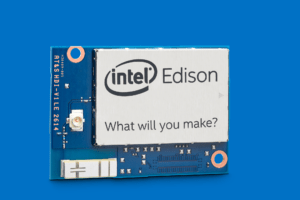High-Performance computing for industrial IoT
By Remco Tolsma, Central Europe Regional Manager, RS Components
The opportunities are many in the paradigm of the Internet of Things (IoT) and especially so in industrial IoT applications. Naturally all the major semiconductor vendors are making strategic forays into this arena, and among them is perhaps the best known of them all.
Intel has made no secret that it is looking to expand its horizons and empower innovators, developers, makers and entrepreneurs in new and fast emerging applications that are being enabled by the IoT and industrial IoT.
To this end, RS Components has been chosen by Intel to be an important instrument in its strategy to address these markets. This has culminated in the recent signing of an agreement enabling RS to supply a wide range of Intel products that target computing and embedded development across numerous applications and IoT-based projects.
Thanks to this agreement, there are now a range of Intel-branded and Intel processor-based products shipping at RS. These include two Intel NUC single-board computers, based respectively on the Intel Atom E3815 processor and the high-performance Intel Core™ i5 processor based 5300U , in addition to the complete Intel Edison development platform, the Intel Compute Stick, and the Arduino Genuino 101.
Single Board Computers
The Intel NUC Core i5 5300U is a highly compact single-board computer that integrates a 2.9GHz dual-core i5 5300U processor with 3MB cache memory, along with integrated graphics, Gigabit Ethernet connectivity and four high-throughput USB 3.0 ports. The processor is excellent for demanding (Digital Signal Processing (DSP) applications and engineers are currently using this powerful resource today to develop IoT applications.
Intel Edison
The Intel Edison platform is a very significant suite of tools for open-source development that targets IoT and wearable computing products. The platform is based around the ultra-small Intel Edison compute module, which works with the Intel Edison breakout board for rapid prototyping and the Intel Edison board for Arduino.
The Intel Edison module is a highly miniaturised product-ready compute module that boasts an advanced 22nm process technology based System-on-Chip (SoC), which integrates a dual-core and dual-threaded 500MHz Intel Atom processor and a 100MHz 32-bit Intel Quark microcontroller.
The platform also integrates dual-band Wi-Fi (2.4 and 5GHz) and low-energy Bluetooth Smart connectivity as well as device-to-device and device-to-cloud connectivity framework for IoT application development.
The Edison expansion board offers interfaces to a wide range of Arduino Uno R3 shields, enabling quick and easy prototyping via open-source hardware and the Arduino software development environment. Input/output and interface options on the board include 20 digital I/O pins, including four pins as PWM outputs, six analogue inputs, UART and a six-pin SPI header.
The Edison breakout board is only slightly larger than the module and exposes the native 1.8V I/O of the Edison module and offers a 0.1in grid I/O array of through-hole solder pads.
Intel Compute Stick
Another new key product is the Intel Compute Stick. Available in a couple of different versions, the Compute Stick is designed to transform a HDMI monitor or TV into a fully functional computer.
Essentially it is a reliable mini PC that looks much like a large USB memory stick, but plugs into a display’s HDMI socket.
It comes with a choice of Windows 10 or Ubuntu Linux operating systems and offers highly competitive levels of performance, storage and wireless connectivity when compared to a full-sized computer, yet at much lower cost and with dimensions of only 103 x 37 x 12mm.
The device also comes with integrated Intel HD graphics, plus connectivity options that include Wi-Fi and Bluetooth 4.0. All it requires to become a traditional office PC, for example, are a power supply, plus wireless keyboard and mouse.
However, a real sweet spot for the product is in the industrial marketplace, where it offers all the capabilities to easily enable digital signage or POS display applications. The Windows version comes with 32GB of eMMC Flash memory and 2GB DDR3L SDRAM; the Ubuntu Linux OS version comes with 8GB eMMC Flash memory and 1GB DDR3L SDRAM.
Genuino 101, powered by Intel
The Genuino 101 is an entry-level learning and development board based around the highly popular Arduino platform. However, in addition to being a powerful learning tool, the Genuino 101 offers more experienced developers the opportunity to prototype IoT designs such as wearables and other smart consumer devices.
Powered by the Intel Curie module, which integrates the 32-bit Intel Quark SoC along with 384kbytes of Flash memory and 80kbytes of SRAM, the board also integrates features such as Bluetooth Smart (Bluetooth Low-Energy) radio and a six-axis combo sensor integrating accelerometer and gyroscope, making the board ideal for “always-on’ sensor hub-based applications and projects such as fitness monitors.
In terms of software, it runs an RTOS (Real-Time Operating System) and open-source based software framework that has been specially developed by Intel, delivering access to the Arduino development environment as well as compatibility with Windows, MAC OS and Linux operating systems.



